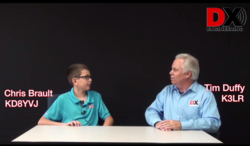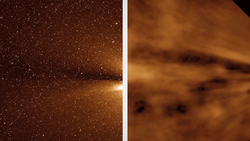 September 21, 2016 Editor: Paul Bourque, N1SFE | ||||
IN THIS ISSUE
The CQWW DX RTTY Contest coming up this weekend is the big draw. You'll find plenty of stations to work from many different countries using some well-known contest calls. If you're able to be on the bands in the next couple of days leading up to the contest, you'll find contest operators on the bands using their own calls, getting the stations checked and ready. A good tune-up for your RTTY station would be participating in the NCCC RTTY Sprint this week. As it's a Sprint, make sure you also have the right messages programmed for the two types of exchanges you'll use in the Sprint. The CQWW RTTY is easier in this regard, as there's just one exchange format. The Weekend of October 1, there are a variety of events to try. The California QSO Party, like the state it represents, is at a larger scale than other single-state QSO parties. Awards for winners include plaques, and twenty top single-operator scores inside and outside California can qualify for a bottle of Northern California Contest Club wine (ops 21 and over, of course). The top score inside and outside California for Youth operators, YL operators, Clubs, and Schools also can earn a plaque. Five other digital mode contests, including one featuring SSTV, and three DX-oriented contests round out the weekend's choices. ARRL Affiliated Club Competition - Club Eligibility Changes TL;DR: Three changes: Club Rosters must be uploaded through a web page. The upload deadline is BEFORE the Contest start. Six-character grid locators are to be used for station location. Also: A new web page of resources to help manage the ARRL Club Competition. These changes will be in effect starting with the 2016 CW Sweepstakes, 2100 UTC on 5 Nov 2016. The ARRL Club Competition consists of nine ARRL-Sponsored contests: January VHF Contest, RTTY Roundup (January), International DX Contest (February and March), June VHF Contest, ARRL 222 MHz and Up Distance Contest (August), September VHF Contest, November Sweepstakes, 160-Meter Contest (December), 10-Meter Contest (December). If your club participates in the ARRL Affiliated Club Competition, there are some changes your club's coordinator (usually the club Secretary or Contest Chairperson) for this activity needs to be aware of relating to how club rosters are managed, and when they are due. For more details, please see the Club Eligibility Changes web page. BUSTED QSOS If you were trying to participate in the Russian RTTY WW Contest on September 19th, you probably didn't have too many contacts. In 2016, the contest was held on September 3rd. Thanks to Mark, K4SO, for pointing this out. In reference to the news item in the last issue about rediscovered Apollo Guidance Computer code in some surplus core memory, Fred, K6DGW, points out that NASA used the same guidance computer software, with customizations for particular missions, over many years. It's likely that code was likely not really "lost," but probably wasn't "neatly and precisely archived." To this point the Apollo 11 source code for the command and lunar modules were posted to Github recently. "The AGC was probably the first operationally deployed computer to use 'real' IC's. The Block II versions (manned missions) were comprised of 5600 3-input NOR gates fabricated in 2800 dual packs (2 gates on one substrate) by Fairchild Semiconductor. It had 32K of read-only core memory, and 2K of read-write core. It was a 1's complement machine. The machine and its machine code assembler were conceived and designed at MIT. MIT wrote all the code. The ROM (read only memory) was 'programmed' by hard-wiring the bits, which were bundled together into 'ropes.' Rick, N6XI, was a student at MIT then and has a lot of 'close to the action' info too." Complete information for all contests follows the Conversation section September 22 September 23 September 24
September 25 September 27 September 28 September 29 September 30 October 1
October 2 October 3 October 4 October 5 Lithium Ion batteries were in the news over the last two weeks with the recall by Samsung of millions of phones which could be prone to overheat and potentially combust. It serves as a reminder to always be careful with portable equipment which may contain these types of cells, and that you should expect greater scrutiny if travelling by air with your equipment. Pigeon Forge, Tennessee will be the site of the W4DXCC DX and Contest Convention September 23-24. Some of the explicitly contest-related activities include "Contest Tips and Tricks" by Ward, N0AX, and "Single Operator Contesting Strategies" by Kirk, K4RO. Many of the other presentations on RFI, Propagation, DX Beacons, and DXpeditions can yield information useful to any type of operation and station building. Amateur Radio Contesting, with a focus on WRTC-2014, was the subject of a recent article in the Epoch Times. The author of the article, Linda Wiegenfeld, worked with Jim, N3BB, author of the book Contact Sport, in developing the article. Here's a thought: Wi-Fi connections via phones and video conferencing software are good enough nowadays so that your monthly radio or contesting club could "host" guest speakers without the expense and burden of travelling. You could conversely stream your club meetings so that those club members who cannot make it can still watch and potentially participate. Ranko, 4O3A, through his company Sky Sat Communications, has released a new version of the Antenna Genius firmware and a Microsoft Windows based application as free downloads. The Antenna Genius product line features 8x1 and 8x2 coax switches with built-in TCP/IP networking and intelligence. Now in their third version, multiple Antenna Genius 8x2 Plus units can now be combined to provide 16, 24, or 32 antennas to 2 port switching capabilities, and expanded with up to 16 switched relays using optional Output Modules, available separately. All Antenna Genius models have three additional user-programmable bands, and programmable amateur band edges. Antenna Genius claims best-in-class minimum port-to-port isolation of 75dB, 3 kW power handling, and support for legacy BCD or pin-to-port switching. FlexRadio users will appreciate Antenna Genius's support for the SmartSDR API providing direct control of the switch via a local area network. In the US, Antenna Genius and other 4O3A products are available via Force 12, or via the FlexRadio online store. In the last issue Rob, N7QT, talked about things to think about when planning to operate a contest from another country. The FCC has just updated the some of the paperwork that you'll need to carry in CEPT countries - see this article for more information. Packet Cluster A packet cluster is a server that you can connect with to primarily obtain 'spot' information -- reports of stations operating on a particular frequency. If named today it might be called a "spot server," but it originated in the days when digital communication for Amateur Radio was accomplished using UHF/VHF radios and the AX.25 protocol. Connections to a cluster are usually via the Internet, but packet radio can still be used with some nodes. Packet clusters exchange information with other packet clusters, and also distribute spots to logging programs, packet cluster clients, web front ends (e.g. DXSummit) or other programs. Spots originate from individual operators via logging programs or web front ends, or are automatically generated by CW and RTTY Skimmer programs. Popular packet cluster server software includes AR-Cluster and CC Cluster, and DX Spider.
The ARRL's Hiram Percy Maxim Award is annually given to an Amateur Radio operator and ARRL member under the age of 21 demonstrating "accomplishments and contributions to both the community of Amateur Radio and the local community ... of the most exemplary nature." This year's award winner is Christopher Brault, KD8YVJ, who is active in a wide range Amateur Radio-related activities, including antenna building and bicycle mobile operation, recruiting and training of new amateurs, and other radio related volunteer activities. Tim Duffy, K3LR, had the opportunity to interview Chris, where the discussion ranged from how school impacts operating time to HOA restrictions impeding the ability to operate HF.
For the first time ever, the origin of solar wind has been determined with certainty. NASA's Solar Terrestrial Relations Observatory, or STEREO, collected observations which allowed scientists to determine that while normally the magnetic forces of the sun confine its plasma to its atmosphere along the magnetic field lines, in the outer fringes of the solar atmosphere, the force of corona particles emanating from the sun exceed the magnetic force's ability to contain it, and the particles diffuse like a gas. At a distance of 20 million miles, observations were made by STEREO, and then processed to remove extraneous background radiation in the visible and non-visible spectra. The corona is visible as it disperses into the solar wind.
The Russian "Woodpecker" over the horizon RADAR is featured in a new YouTube video. Though it was one of the scourges of the ham bands back then, hearing it again in the video makes me almost sad for its near 30 year absence. Almost. (Chris, ZS6EZ) A list of logs received, along with claimed scores, for the 39th August UHF Contest have been posted. The list includes those received via Cabrillo file submission. The WRTC-2018 qualifying standings continue to be updated with the scores of recent contests. Use the Bandmap When Searching and Pouncing If you're tuning up or down the band, enter each station you copy or work into your logging program's bandmap. When you revisit a frequency later, the bandmap will help you more quickly determine whether you've worked the station before. Even in a casual contest operation, it will reduce frustration and increase your rate. It's also a good way to develop that skill. Many loggers have a setting for the time interval after which an entry in the bandmap 'expires' and disappears. This is sometimes called the 'packet spot timeout,' but it applies to calls that you enter by logging or inserting into the bandmap by typing them, even when you're not using packet cluster spots. You'll likely have to change this interval based on a particular contest and conditions, and how you are operating. In a single-band contest for say 160 meters, stations may not move around too much in the middle of the contest, and you may want to use a longer timeout. If propagation is rapidly changing and stations are prone to move around a bit, a shorter interval would be in order. For example, for a sprint-format contest, the N1MM logger documentation suggests setting it to 1 minute, as stations don't really have run frequencies. You can check the format of your log for the CQWW contests before submitting it by using the CQWW Log Check page. Note that you still have to submit your log after using this tool. (Ed, W0YK, via CQ-Contest) Scott, N3FJP, has been working with Dave, W1HKJ, author of Fldigi, and Jeff, N7YG, author of PSK Express and Digital Engine, to provide greater integration between those programs and Scott's software. Scott made some changes to his API, and has re-released versions of his Amateur Contact Log and CQWW DX RTTY programs. In related news, the new release of Win4K3Suite supports direct logging into N3FJP's Amateur Contact Log and Contest logs from Win4K3's terminal mode. In terminal mode, CW, FSK-D and PSK-D contacts can be made using the built-in keyer and decoding capabilities of the K3/K3S, KX3, and KX2. If you're trying to record contest audio with an Elecraft K3/K3S, you'll want to check out the "Recording Contest Audio" article by Bob Wolbert, K6XX, in the Northern California Contest Club's JUG newsletter for August, 2016. It makes mention of a recent firmware update that Elecraft made so that transmit audio will be routed to the Line Output at a fixed level. When adding extra circuits for the ham shack, you should understand the electrical codes that apply to your situation. Choosing the right conduit size is more than just making the wires fit. There's an app for sizing electrical conduit based on conductor capacity, appropriately called "Conduit Fill Calculator" and available for your iPhone. You can also use this one from a web browser. Check your local codes for the appropriate percentage of fill allowed. (Chuck, WA7BRL via WWDXC email reflector) The ESP8266 chip is at the heart of many low-cost electronics projects that have wireless capability. The follow-on chip, ESP32, has just been released, and the expanded capabilities are looking promising for the next few years of wirelessly-connected projects. Spots that have originated from the Reverse Beacon Network (ReverseBeacon.net) are usually turned OFF as the default setting when you log into a packet cluster from your logging program. In CW and RTTY Contests, you're missing out on a lot of spots if you're not using them if your operating category allows. The usual incantation to turn them on is SET/SKIMMER or a variation of that command. During major contests, you may get more spots than your logging computer can handle, depending on the age and capabilities of your computer hardware. Symptoms will be your logging program becoming unresponsive, or the inability to send CW without delay. Cut down on the local processing burden by setting up appropriate filters to get rid of spots you can't use at your cluster node, before your computer gets them. Depending on the software used by the packet cluster you are connected to, SET/FILTER or SET/FILTERS will help you. Poor Propagation? I ain't got poor propagation... I just ain't workin' anything! My apologies to Yogi Berra. During our Washington State Salmon Run two-transmitter effort last weekend, I got on the "not-open band" radio and I needed to make something happen. During the middle of the day there were no stations to work in the bandmap, so I tuned across 15 meters, but didn't hear anything except a JT-65 signal. Huh. I turned on skimmer spots by typing SET/SKIMMER into N1MM+ Logger's packet window, and CQed away. I watched as the skimmer spots rolled in: 21dB in Ohio. 27dB in Massachusetts. 32 dB in Pennsylvania. 31dB in New York. These readings were subjective, but indicated that if anyone was listening in those locations, they should have been able to hear me. I kept at it for nearly five minutes without a caller, wondering if anyone else was on 15 or watching skimmer spots. Finally, I started to get some callers, and eventually ended up with nearly 70 contacts on that band. I scanned around the band a bit on the 2nd VFO after I started working people - others were finally noticing that the band was open and were making contacts as well. Lately it's been easy to ignore certain bands because we all know the conditions are just terrible. I'm glad I reminded myself early in this year's fall contest season to base my in-contest decisions with hard data and persevere in CQing into a quiet, but ultimately open, band. That's all for this time. Remember to send contesting result announcements, contest related stories, flea market pictures, book reviews, tips, techniques, press releases, errata, pictures, stories, blog links, and predictions, to contest-update@arrl.org 73, Brian N9ADG 22 Sep - 5 Oct 2016 An expanded, downloadable version of QST's Contest Corral in PDF format is available. Check the sponsor's Web site for information on operating time restrictions and other instructions. HF CONTESTS CWops Mini-CWT Test, Sep 21, 1300z to Sep 21, 1400z, Sep 21, 1900z to Sep 21, 2000z, Sep 22, 0300z to Sep 22, 0400z; CW; Bands: 160, 80, 40, 20, 15, 10m; Member: Name + Member No., non-Member: Name + (state/province/country); Logs due: September 24. VHF+ CONTESTS AGCW VHF/UHF Contest, Sep 24, 1400z to Sep 24, 1700z (144), Sep 24, 1700z to Sep 24, 1800z (432); CW; Bands: 144 MHz, 432 MHz; RST + "/" + Serial No. + "/" Power class + "/" + 6-character grid locator; Logs due: October 10. UBA ON Contest, 6m, Sep 25, 0700z to Sep 25, 1000z; CW, Phone; Bands: 6m Only; ON: RS(T) + Serial No. + ON Section, non-ON: RS(T) + Serial No.; Logs due: October 16. ARRL EME Contest, Sep 24, 0000z to Sep 25, 2359z; CW, Phone, Digital; Bands: 50-1296 MHz; Signal report; Logs due: December 21. 220 MHz Fall Sprint, Sep 27, 1900z to Sep 27, 2300z; not specified; Bands: 222 MHz; 4-character grid square; Logs due: October 11. Also, see Texas QSO Party, Classic Exchange, Tara PSK Rumble, above. September 23, 2016 September 24, 2016 September 25, 2016
September 26, 2016 September 27, 2016 September 29, 2016 September 30, 2016 October 1, 2016 October 2, 2016 October 3, 2016 October 4, 2016 October 5, 2016 ARRL Information Click here to advertise in this newsletter, space subject to availability. Your One-Stop Resource for Amateur Radio News and Information ARRL membership includes QST, Amateur Radio's most popular and informative journal, delivered to your mailbox each month. Subscribe to NCJ - the National Contest Journal. Published bimonthly, features articles by top contesters, letters, hints, statistics, scores, NA Sprint and QSO Parties. Subscribe to QEX - A Forum for Communications Experimenters. Published bimonthly, features technical articles, construction projects, columns and other items of interest to radio amateurs and communications professionals. Free of charge to ARRL members: Subscribe to The ARRL Letter (weekly digest of news and information), the ARES E-Letter (monthly public service and emergency communications news), Division and Section news -- and much more! ARRL offers a wide array of products to enhance your enjoyment of Amateur Radio. Visit the site often for new publications, specials and sales. Donate to the fund of your choice -- support programs not funded by member dues! Reprint permission can be obtained by sending email to permission@arrl.org with a description of the material and the reprint publication. ACKNOWLEDGEMENTS ARRL Contest Update wishes to acknowledge information from WA7BNM's Contest Calendar and SM3CER's Contest Calendar. | ||||









